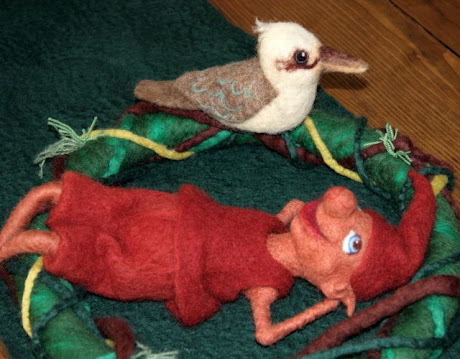The wet weather has offered me an opportunity to
tidy and re-organise . . . and I found these pictures
taken when I made some nuno felted baby blankets, so I thought I'd share them now . . .
I love to make them. They end up so soft and snuggly.
It's just a shame I don't have a photo of a baby wrapped in one !
Anyway, I buy fine cotton voile
and use the whole width (discarding the selvedges).
I lay out fine stripes of merino fleece,
taking care to evenly cover the edges
then lay silk randomly across the fleece,
add leaves and silk roses
until I'm happy with the layout.
Then secure the silk with a superfine cobweb of merino
and wet it all down with a fine mist of room temperature soapy water,
soaking the fibres until they flatten
Double check all the voile edges to ensure they are covered with fleece
and that nothing else has strayed from it's place
and roll it up slowy.
You will often find the voile lifts and bubbles, trying to let air escape
and may cause the pattern to move.
Check this as you go and adjust as necessary
. . . you won't have another chance for a little while to do this without risking
losing your pattern.
Also, with the fibres wet, it's often easier to see
how well you've anchored your silk, so check this too as you roll it up.
If there's not enough - now is the time to add more.
Nuno felt is a fussy (and hugely rewarding) way to felt - you have to be very patient
and begin rolling back and forth with little to no effort at first.
Do this for some time before opening the roll for the first time.
Why ? Well, try to imagine all the fibres laying in there next to each other.
What we need to do is gently push the fibre ends through the voile so they are able to
meet and grip each other on the other side of the voile before they begin to
felt together on the surface of the fabric.
This is the begining of the process of felting which will cause
the voile to be pulled up within the fleece and create
the puffy effect where there are no fibres.
Moving the roll gently at first will help the fibre ends to wriggle their way through
the voile and form strong bonds with each other.
The photo above shows the first time the roll was opened.
Take time to gently check the edges and then roll it back up from the other end.
Continue this process until you can feel and see
the fibres easily on the wrong side of the voile
and continue rolling, gradually increasing pressure
and rotating the fabric from time to time.
Then it gets exciting.
Just when you think you'll be there
rolling away until Christmas next year,
you will see the rows of fleece begin to firm up and become stronger.
It will not feel so fragile and this is the time to begin gently tossing the blanket.
Begin gently, tossing several times, then lay out the fabric,
bringing it always back to the shape you've chosen, check the edges and repeat
. . . the fabric will begin to pucker.
As it puckers more, you can turn your toss into a throw
and increase the intensity. This forces the fibres hard into the voile
where they will mesh even more tightly.
continue until the blanket is just a little bigger than you'd like - and it's time to rinse.
I rinse in luke warm water and throw a few more times (which will cause more shrinkage),
then submerge in fresh water with a little white vinegar
to help neutralise the effects of the soap.
Now gently squeeze out the excess water, pull into shape and lay flat to dry.
And it's finally finished !
Please note : This is just the way I do it
- if you're new to Nuno Felting, have a hunt around and read up first .
.. be prepared to have a play with something small before you start something this size.
A class is often a good option - if its at all possible.
That way, you not only learn from your tutor but also those around you - and who knows
what experience they might have to share?
And likewise ... if I can help - I'm only an email away !














6 comments:
♥ so beautiful!
Absolutely beautiful! These would make a lovely Christening shawl
x
Dearest Tiffane,
Just admiring your craft! This is so lovely. Got here via Tammy, she received your heart gifts. Have you ever checked out this Swedish blog: http://astridshandarbeten.blogspot.com/
Astrid does lots of felting for the Wabbie Foundation.
Hugs to you,
Mariette
I am a new follower, wanting to learn about felting--this is just gorgeous-thank you for tutorial Kathy
Hi I really enjoy your blog s well as learning lots of new things from you. These balnkets are beautiful. Where do you buy your fabric. i have used different types of fabric for the garments I make but it has all been not very wide. Gappy felting
Hi Suzmud,
I've found the best place for cotton voile and muslin is Spotlight. It's not always possible to find what you're looking for, so if you find it, buy bulk !
Post a Comment